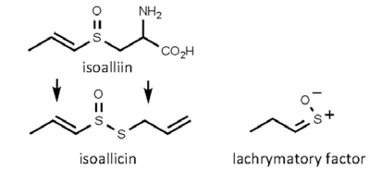 Allium cepa
Allium cepa
onion • bulb onion
Back to “Salad herbs and herb mixtures: onion (Allium cepa) ”
Back to “Culinary herbs: onion (Allium cepa)”
Allium cepa L. (Alliaceae); ui (Afrikaans); cong tou, yang cong (Chinese); oignon (French); Küchenzwiebel (German); cipolla (Italian); tamanegi (Japanese); bawang (Malay); cebola (Portuguese); cebolla (Spanish)
DESCRIPTION A rounded bulb covered with a brown or purplish, papery skin. It has a strong flavour and cutting releases pungent volatile compounds that cause weeping. Onions are used fresh, dried or pickled.
THE PLANT A biennial plant with hollow leaves and rounded clusters of small white flowers. Shallot (A. cepa var. ascalonicum) differs in forming clusters of bulbs.1,2 The name “scallion” is the original name for the shallot but is now often used for spring onions, which may also include leeks or Welsh onion (in the USA) or young Allium cepa plants.1,2 The tree onion (A. ×proliferum) has small bulbs that develop within the inflorescence. Allium chinense (Chinese onion) is an Asian species known as chiao tou in China or rakkyo in Japan. The small bulbs are fried or they are pickled in vinegar or brine.
ORIGIN An ancient cultigen (first recorded 3000 BC), thought to be derived from wild species in the Middle East (possibly Iran and Afghanistan).2
CULTIVATION Onions are grown as an annual crop. Critical for success are the choice of cultivar, the time of sowing, long daylight hours during bulb formation and light soils. Seedlings are set out 10 cm (4 in.) apart in rows of 30 cm (1 ft) wide. Direct sowing (10 mm / ⅖ in. deep) requires thinning, thus providing young onions for the kitchen.
HARVESTING Drying is encouraged by reducing irrigation and by bending over the tops. Select thin-necked bulbs for storage because they keep better. Dry onions should be stored in a shaded, well-ventilated place.
CULINARY USES Few culinary herbs rival the onion in popularity and diversity of uses.3 The bulbs are eaten raw as an ingredient of salads, soups, sauces, stews and curries or may be processed for use in pickles and chutneys. Adding chopped onions as an ingredient to a sour fruit sauce turns it into a chutney. The small bulbs of rakkyo (chiao tou) may be fried or are commonly pickled in brine or vinegar. Examples of popular dishes include French onion soup (soupe à l’oignon) and slaphakskeentjies (an old Cape favourite of small onions cooked in a sweet-sour sauce).
FLAVOUR COMPOUNDS Onions are rich in sugar, which caramelizes during the frying process. This, together with the enzymatic breakdown of sulphur compounds, results in the delicious savoury taste. Four non-volatile, odourless sulphoxides occur in Allium species as the main flavour and odour precursors, of which isoalliin is characteristic of A. cepa.4 When cells are damaged, isoalliin is converted by alliinase to form isoallicin, the main thiosulphinate intermediate in A. cepa (0.14–0.35 μmol per g wet weight).4 Isoallicin is further converted to volatile sulphur compounds. The weeping reaction caused by cutting onions with a blunt knife is due to another volatile sulphur compound known as lachrymatory factor (syn-propanethial S-oxide).4

NOTES Onions are known to inhibit blood-clotting and hence thrombosis.
1. Gregory, M., Fritsch, R.M., Friesen, N.W., Khassanov, F.O., McNeal, D.W. 1998. Nomenclator Alliorum. Allium names and synonyms – a world guide. Royal Botanic Gardens, Kew.
2. Fritsch, R.M., Friesen, N. 2002. Evolution, domestication and taxonomy. In: Rabinowitch, H.D., Currah, L. (Eds), Allium crop science: recent advances, pp. 5–30. CABI Publishing, New York.
3. Farrel, K.T. 1999. Spices, condiments and seasonings. Aspen Publishers, Gaithersburg, USA.
4. Benkeblia, N., Lanzotti, V. 2007. Allium thiosulfinates: chemistry, biological properties and their potential utilization in food preservation. Food1: 193–201.